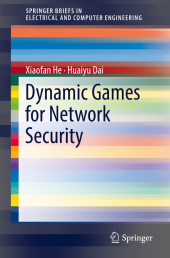 Neuerscheinungen 2018Stand: 2020-02-01 |
Schnellsuche
ISBN/Stichwort/Autor
|
Herderstraße 10
10625 Berlin
Tel.: 030 315 714 16
Fax 030 315 714 14
info@buchspektrum.de |

Huaiyu Dai, Xiaofan He
(Beteiligte)
Dynamic Games for Network Security
1st ed. 2018. 2018. x, 74 S. 15 SW-Abb., 14 Farbabb. 235 mm
Verlag/Jahr: SPRINGER, BERLIN; SPRINGER INTERNATIONAL PUBLISHING 2018
ISBN: 3-319-75870-5 (3319758705)
Neue ISBN: 978-3-319-75870-1 (9783319758701)
Preis und Lieferzeit: Bitte klicken
The goal of this SpringerBrief is to collect and systematically present the state-of-the-art in this research field and the underlying game-theoretic and learning tools to the broader audience with general network security and engineering backgrounds. Particularly, the exposition of this book begins with a brief introduction of relevant background knowledge in Chapter 1, followed by a review of existing applications of SG in addressing various dynamic network security problems in Chapter 2.
A detailed treatment of dynamic security games with information asymmetry is given in Chapters 3-5. Specifically, dynamic security games with extra information that concerns security competitions, where the defender has an informational advantage over the adversary are discussed in Chapter 3.
The complementary scenarios where the defender lacks information about the adversary is examined in Chapter 4 through the lens of incomplete information SG. Chapter 5 is devoted to the exploration of how to proactively create information asymmetry for the defender´s benefit.
The primary audience for this brief includes network engineers interested in security decision-making in dynamic network security problems. Researchers interested in the state-of-the-art research on stochastic game theory and its applications in network security will be interested in this SpringerBrief as well. Also graduate and undergraduate students interested in obtaining comprehensive information on stochastic game theory and applying it to address relevant research problems can use this SpringerBrief as a study guide. Lastly, concluding remarks and our perspective for future works are presented in Chapter 6.


